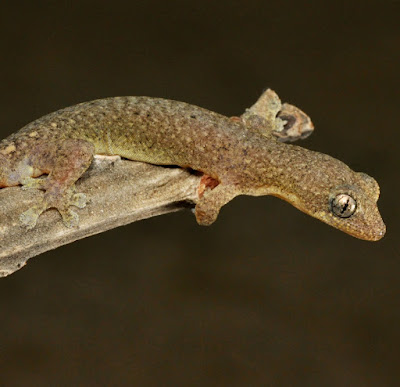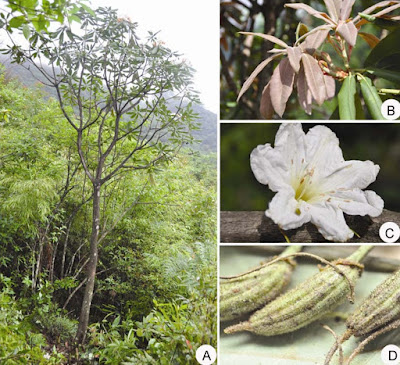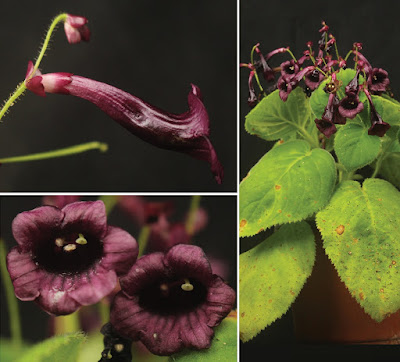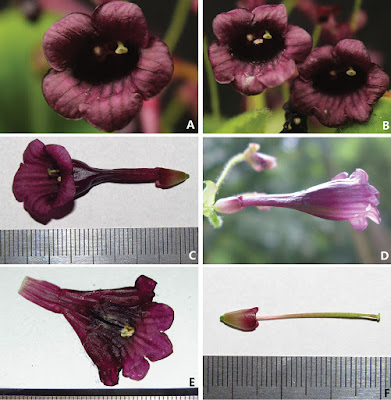[Most Recent Entries] [Calendar View]
Wednesday, March 14th, 2018
| Time | Event | ||||||
| 1:45a | [Herpetology • 2018] Hemiphyllodactylus hongkongensis • A New Species of Hemiphyllodactylus (Squamata: Gekkonidae) from Hong Kong
Abstract A new species of gekkonid, Hemiphyllodactylus hongkongensis sp. nov., is described based on a series of specimens collected from Hong Kong SAR, China. The new species can be distinguished from other known congeners by molecular divergence in the mitochondrial ND2 gene and morphological characters including 5–6 chin scales; a manual lamellar formula of 3–3(4)–4–4; a pedal lamellar formula of 3(4)–4(5)–4(5)–4; 24–25 continuous femoral and precloacal pores; 12–15 dorsal scales and 9–10 ventral scales contained in diameter of eye. At present, the genus Hemiphyllodactylus comprises 22 described species. Keywords: Reptilia, China, Hemiphyllodactylus hongkongensis sp. nov., mitochondrial ND2, molecular phylogeny, morphology, slender gecko
Hemiphyllodactylus hongkongensis sp. nov. Etymology. The specific epithet “hongkongensis’ is in reference to the type locality, Hong Kong SAR, China. As an English common name, we suggest “Hong Kong Slender Gecko”. Distribution. In Hong Kong, records of Hemiphyllodactylus hongkongensis have been made on Hong Kong Island, Shek Kwu Chau, and Po Toi Island (Karsen et al. 1998). Yik-Hei Sung, Wing-Ho Lee, Ho-Nam Ng, Yanjie Zhang and Jian-Huan Yang. 2018. A New Species of Hemiphyllodactylus (Squamata: Gekkonidae) from Hong Kong. Zootaxa. 4392(2); 361–373. DOI: 10.11646/zootaxa.4392.2.8 researchgate.net/publication/323646190_A | ||||||
| 2:54a | [Paleontology • 2018] Late Maastrichtian Pterosaurs from North Africa and Mass Extinction of Pterosauria at the Cretaceous-Paleogene Boundary Abstract Pterosaurs were the first vertebrates to evolve powered flight and the largest animals to ever take wing. The pterosaurs persisted for over 150 million years before disappearing at the end of the Cretaceous, but the patterns of and processes driving their extinction remain unclear. Only a single family, Azhdarchidae, is definitively known from the late Maastrichtian, suggesting a gradual decline in diversity in the Late Cretaceous, with the Cretaceous–Paleogene (K-Pg) extinction eliminating a few late-surviving species. However, this apparent pattern may simply reflect poor sampling of fossils. Here, we describe a diverse pterosaur assemblage from the late Maastrichtian of Morocco that includes not only Azhdarchidae but the youngest known Pteranodontidae and Nyctosauridae. With 3 families and at least 7 species present, the assemblage represents the most diverse known Late Cretaceous pterosaur assemblage and dramatically increases the diversity of Maastrichtian pterosaurs. At least 3 families—Pteranodontidae, Nyctosauridae, and Azhdarchidae—persisted into the late Maastrichtian. Late Maastrichtian pterosaurs show increased niche occupation relative to earlier, Santonian-Campanian faunas and successfully outcompeted birds at large sizes. These patterns suggest an abrupt mass extinction of pterosaurs at the K-Pg boundary. Nicholas R. Longrich, David M. Martill and Brian Andres. 2018. Late Maastrichtian Pterosaurs from North Africa and Mass Extinction of Pterosauria at the Cretaceous-Paleogene Boundary. PLoS Biol. 16(3): e2001663. DOI: 10.1371/journal.pbio.2001663 Author summary: Pterosaurs were winged cousins of the dinosaurs and lived from around 200 million years ago to 66 million years ago, when the last pterosaurs disappeared during the Cretaceous-Paleogene extinction that wiped out the dinosaurs. The pterosaurs are thought to have declined in diversity before their final extinction, suggesting that gradual processes played a major role in their demise. However, pterosaur fossils are very rare, and thus, it is unclear whether pterosaurs were really low in diversity at this time or whether these patterns merely result from a paucity of fossils. We describe new pterosaur fossils from the end of the Cretaceous in Morocco, including as many as 7 species. They represent 3 different families and show a large range of variation in size and skeletal proportions, suggesting that they occupied a wide range of ecological niches. | ||||||
| 4:37a | [Botany • 2015] Rhododendron leigongshanense • A New Species (Ericaceae) from southwest China
Abstract Rhododendron leigongshanense, a new species from Leishan County, Guizhou Province, China, is described and illustrated. The new species is close to R. magniflorun W.K. Hu and R. glanduliferum Franchet, but differs by having stipitatus glands on leaf abaxial surface, corolla trumpet-shaped with 7 lobes, 7.58.0 cm long, 810 cm in diameter and calyx 7- lobed. Keywords: China; Ericaceae; New species; Rhododendron. Rhododendron leigongshanense C.H. Yang, Z.G. Xie, Y.F. Yu & Z.R. Yang, sp. nov. Diagnosis: The new species is morphologically similar to R. magniflorum and R. glanduliferum, but differs by its leaf abaxial surface with stipitatus glands, corolla trumpet-shaped with 7 lobes, 7.5–8.0 cm long, 8–10 cm in diameter, and calyx 7-lobed. ..... Etymology: The specific epithet is named after the type locality Leigongshan. Vernacular name: Leigongshan Dujuan. Habitat: This species grows in evergreen broad-leaved forests on limestone hills at 1,400 m. Distribution: So far, this species is only known from the type locality Leigongshan Nature Reserve, Leishan County, Guizhou Province, southwest China. Cheng-Hua Yang, Zheng-Guo Xie, Yong-Fu Yu and Zhi-Rong Yang. 2015. Rhododendron leigongshanense (Ericaceae), A New Species from China. Bangladesh Journal of Plant Taxonomy. 22(2); 119-123. DOI: 10.3329/bjpt.v22i2.26073 | ||||||
| 4:59a | [Botany • 2018] Didymocarpus puhoatensis • A New Species (Gesneriaceae) from Vietnam
Abstract Didymocarpus puhoatensis, a new species from Vietnam is described and illustrated with photographs. The new species is morphologically similar to D. brevicalyx and D. epithemoides, but can be easily distinguished by a combination of characters. So far, five species have been recorded in the genus Didymocarpus from Vietnam. Keywords: Didymocarpus, Gesneriaceae, plant taxonomy, Vietnam Didymocarpus puhoatensis X.Hong & F.Wen, sp. nov. Diagnosis: Although it is morphologically similar to D. brevicalyx, it differs by stem densely pubescent, orbicular purple bracts, apices of calyx lobes obtuse, filaments glabrous, staminodes 2; and also similar to D. epithemoides, but differs from the latter in having purple calyx, funnel-form corolla, 4–5 cm long, glabrous, dark purple-blackish, ovary glandular puberulent. Etymology: The specific epithet is derived from the type locality, Pu Hoat Nature Reserve, Nghệ An Province, Vietnam. Distribution and habitat: This new taxon is an endemic species from Pu Hoat Nature Reserve of Vietnam. The species grows on limestone rocks in tropical monsoon forest with sufficient seasonal run-off water, at an elevation of 390 m a.s.l. It distributes much lower in altitude and the habitat is much hotter and more humid than other species with stems of the genus. Xin Hong, Zhen-Long Li, Stephen Maciejewski, Fang Wen and Truong Van Do. 2018. Didymocarpus puhoatensis (Gesneriaceae), A New Species from Vietnam. In: Jin X-H, Shui Y-M, Tan Y-H, Kang M (Eds) Plant Diversity in Southeast Asia. PhytoKeys. 94; 87-93. DOI: 10.3897/phytokeys.94.21650 | ||||||
| 11:21a | [Herpetology • 2018] Scolecoseps broadleyi • A New Species of Scolecoseps (Reptilia: Scincidae) from coastal north-eastern Mozambique
ABSTRACT Seven specimens of Scolecoseps Loveridge, 1920 from the vicinity of Palma on the north coast of Mozambique are compared morphologically with other known material of this genus. The new material can be distinguished morphologically from all other Scolecoseps by the presence and position of certain head scales, particularly a supraciliary and four small suboculars, a small mental and high subcaudal counts. It is described as a new species, Scolecoseps broadleyi sp. nov. The new species is found in coastal savannah habitat under leaf litter of Berlinia orientalis trees, in sandy soils in close proximity to large wetlands. Its currently known distribution is south of the range of Scolecoseps litipoensis Broadley, 1995 and north of that of Scolecoseps boulengeri Loveridge, 1920. We provide a review of the available literature for the genus Scolecoseps and highlight the necessity for additional research on these poorly known fossorial skinks. KEYWORDS: arenosols, coastal savannah habitat, fossorial, sandy soils, skinks
Scolecoseps broadleyi sp. nov. Etymology— Named in honour of Donald George Broadley in recognition of his numerous contributions to African herpetology. Don assisted greatly with the description of this new species.
Luke Verburgt, Ursula K. Verburgt and William R. Branch. 2018. A New Species of Scolecoseps (Reptilia: Scincidae) from coastal north-eastern Mozambique. African Journal of Herpetology. DOI: 10.1080/21564574.2017.1413014 |
| << Previous Day |
2018/03/14 [Calendar] |
Next Day >> |










